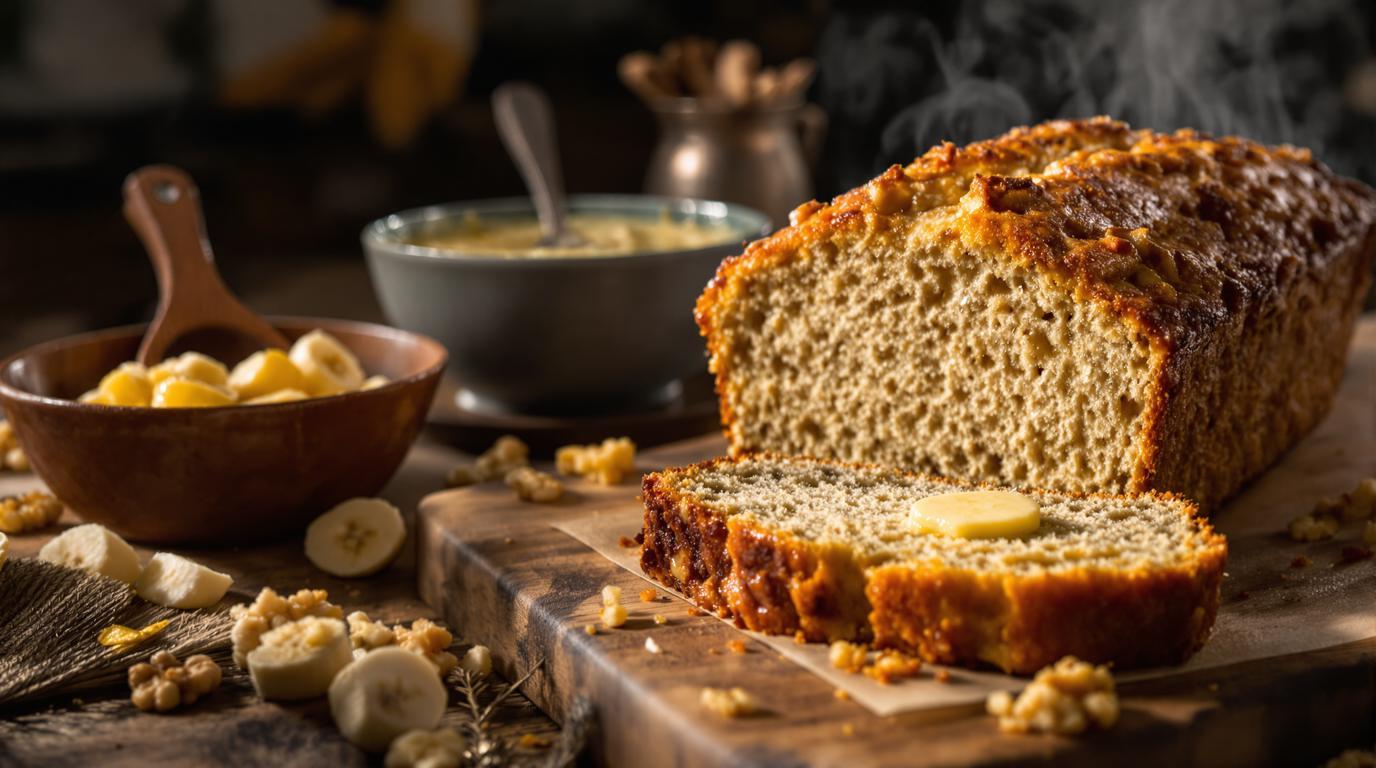There’s something deeply comforting about the aroma of banana bread wafting through a kitchen. My grandmother always said that the humble banana bread represents the perfect marriage of practicality and indulgence—a ingenious way to transform spotty, overripe fruit into something magnificent. While clearing my grandmother’s recipe box recently, I discovered her treasured banana bread recipe, complete with a surprising annotation about incorporating banana peels. This unconventional practice stems from Depression-era cooking when nothing went to waste. Today, I’ll share both approaches, honoring tradition while exploring the experimental edge of banana bread making. 🍌✨
The Story Behind Resourceful Banana Bread 📖
Banana bread as we know it emerged during the Great Depression when frugal home cooks refused to waste even the most unappealing bananas. This beloved quick bread evolved differently across cultures—in the Caribbean, you’ll find versions laced with dark rum, while Indian households like my grandmother’s occasionally repurposed banana peels in savory dishes like banana peel curry. My grandmother, always looking to merge traditions, experimented with adding prepared peels to her banana bread for added texture and nutrition. While unconventional, this approach aligns beautifully with today’s zero-waste cooking movement. 🌍
Essential Ingredients for Classic Banana Bread 🧾
The magic of banana bread lies in its simplicity. You’ll need 1½ cups (180g) all-purpose flour, 1 teaspoon baking soda, ½ teaspoon salt, ½ cup (100g) sugar, ¼ cup (57g) softened butter, 3 very ripe bananas, 1 large egg, and 1 teaspoon vanilla extract. Optionally, ¾ cup toasted walnuts adds wonderful texture and nutty depth. The key is using properly ripened bananas—the ones with dark speckles or even largely blackened peels contain significantly more natural sugar and softer starches, creating that distinctive banana bread flavor we all love.
Chef’s Note: The bananas should be so ripe that they’re uncomfortable to look at. That’s when they develop the complex sweetness and heightened aromatics that elevate banana bread from good to unforgettable. If your bananas aren’t quite there, place them in a paper bag with an apple overnight to speed ripening. 💡
Step-by-Step Instructions 📝
1. Preheat your oven to 350°F (175°C) and prepare a 9×5-inch loaf pan with butter or parchment.
2. Mash the bananas thoroughly in a large bowl, removing any stringy bits. The texture should resemble thick applesauce.
3. In the same bowl, whisk in the melted butter, then add the egg, sugar, and vanilla extract until well combined but not overmixed.
4. In a separate bowl, whisk together the flour, baking soda, and salt, then gently fold into the wet ingredients just until no dry flour remains visible. The batter should look somewhat lumpy—this is perfect!
5. If using walnuts, fold ¾ of them into the batter and reserve the remainder for topping.
6. Pour the batter into your prepared pan, create a slight depression along the center with the back of a spoon (this helps the loaf rise evenly), sprinkle with remaining walnuts, and bake for 60-70 minutes until a wooden skewer comes out clean.
7. Allow the bread to cool in the pan for 15 minutes, then transfer to a wire rack for at least 45 minutes before slicing—difficult as it may be to wait! ⏱️
Chef’s Secret Techniques 🤫
The true secret to exceptional banana bread lies in two techniques: proper banana preparation and minimal mixing. For the former, I always let my mashed bananas sit for 5 minutes before incorporating—this releases their natural enzymes and deepens flavor. For the latter, I stop folding the moment the dry ingredients disappear. Overmixing develops gluten, resulting in tough, dense bread rather than the tender crumb we desire.
For those adventurous souls who want to try my grandmother’s peel-inclusive version, prepare the peels by washing them in a 1:3 vinegar-water solution, blanching for 10 minutes, then scraping away the soft inner layer and shredding the remainder thinly. Substitute ½ cup of prepared peels for one banana in the recipe. The result offers subtle bitterness that beautifully counterbalances the sweetness—reminiscent of how depression-era bakers created complexity with limited ingredients. 🔍
Serving & Presentation Tips 🍽️
Banana bread is enormously versatile. Serve it warm with a pat of salted butter for breakfast, or transform it into an elegant dessert by toasting slices lightly and topping with a dollop of mascarpone and a drizzle of honey. For a delightful contrast reminiscent of grilled peaches with burrata, serve with a scoop of vanilla bean ice cream and a light dusting of cinnamon.
The bread keeps beautifully at room temperature for three days when properly wrapped, making it perfect for advance preparation. For longer storage, slice and freeze with parchment between pieces—just like grandma’s fudgy brownies, the freezer works wonders for preserving that just-baked quality. 💕
